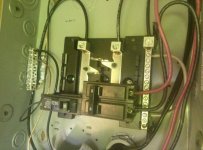Zarezhu
Member
Hey guys. Instead of paying my electrician his $150 minimum for a 5-10 minute job, I've decided I'm gonna tackle it myself.
I've got a 50 amp sub panel, and I need to install a 15a 220v circuit for my 230/208v 15a 24kbtu Breeze mini split.
Since the ac plug is a three pronged plug, I only need THREE wires, correct? Both hots, and the ground? Can I avoid the neutral bus bar completely for this circuit?
The plug on my air handler, which is the only plug for the whole unit, is a 230/208v plug, which has the horizontal orientation of the hots (opposed to the 220v plugs on my ballasts, that have the vertical -.- plugs).
The breaker install seems really straight forward. I need a double pole 15A 220v breaker to pop into my sub panel, correct?
I'm about to go to home depot to buy my breaker, my receptacle, my receptacle cover, and my 10 gauge wire for my circuit. I already have a large roll of 8 gauge wire, could I use it for both hots and my ground, or is it a bad idea to go overkill on wire sizing?
Other than that, I'm confident in the install. I'm only wiring the plug a few feet from the panel. I know how to attach the 2 hots and the ground to the receptacle, and I'm also aware of how to screw both hots into the breaker and the ground to the ground bus bar.
I will also use a voltage tester to verify the outlet is getting 220v, prior to plugging my brand new and gorgeous 24k btu mini.
Thanks for the help in advance guys!
I've got a 50 amp sub panel, and I need to install a 15a 220v circuit for my 230/208v 15a 24kbtu Breeze mini split.
Since the ac plug is a three pronged plug, I only need THREE wires, correct? Both hots, and the ground? Can I avoid the neutral bus bar completely for this circuit?
The plug on my air handler, which is the only plug for the whole unit, is a 230/208v plug, which has the horizontal orientation of the hots (opposed to the 220v plugs on my ballasts, that have the vertical -.- plugs).
The breaker install seems really straight forward. I need a double pole 15A 220v breaker to pop into my sub panel, correct?
I'm about to go to home depot to buy my breaker, my receptacle, my receptacle cover, and my 10 gauge wire for my circuit. I already have a large roll of 8 gauge wire, could I use it for both hots and my ground, or is it a bad idea to go overkill on wire sizing?
Other than that, I'm confident in the install. I'm only wiring the plug a few feet from the panel. I know how to attach the 2 hots and the ground to the receptacle, and I'm also aware of how to screw both hots into the breaker and the ground to the ground bus bar.
I will also use a voltage tester to verify the outlet is getting 220v, prior to plugging my brand new and gorgeous 24k btu mini.
Thanks for the help in advance guys!



